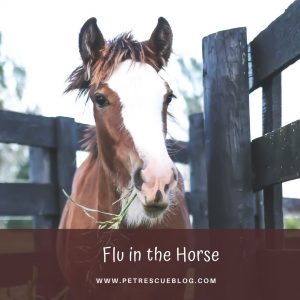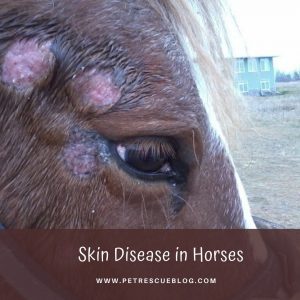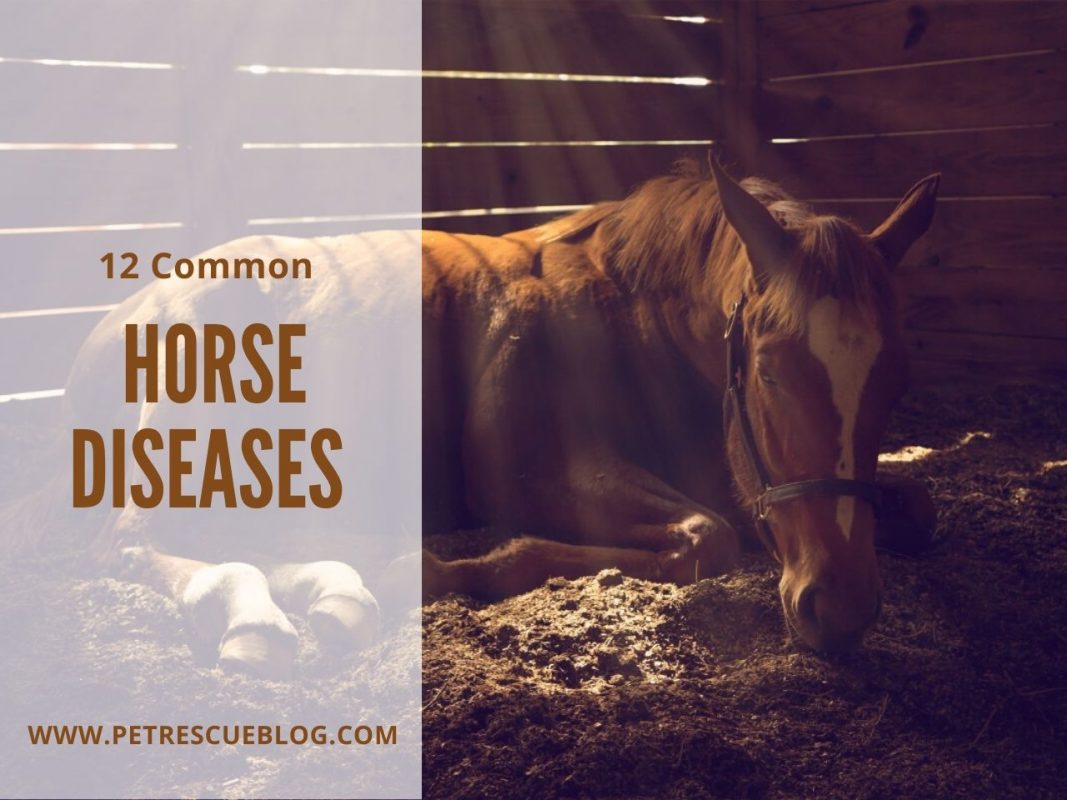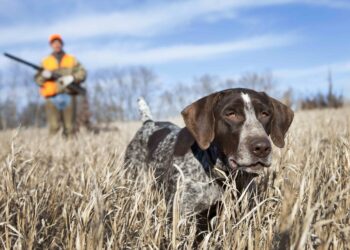No doubt, the horse is one of the animals that has contributed most to the overall development of humanity. A good proof of its importance is that veterinary medicine appeared almost exclusively to treat the affections and pathologies of this noble animal.
Related: 500 Horse and Racehorse Names
In this Pet Rescue Blog “12 Most Common Horse Diseases”, we write a brief guide to the most common diseases of horses, known since Antiquity and some of which have been described in multiple centenary treatises.
What are the most common diseases of the horse?
- Colic
- Tetanus
- Influenza
- Piroplasmosis
- Cushing’s syndrome
- Gourme
- Sarcoid
- Ringworm
- Dermatophilosis
- Melanoma
- Summer dermatitis
- Leptospirosis
Let’s discuss these diseases briefly
Horse Colic
Colic is a set of diseases that cause spasmodic pain in the abdomen. Remember that the causes can be multiple, and therefore its treatment is different depending on what it obeys, but in general, the signs that are found in a horse suffering from colic are:
- Sweat
- Nervousness
- Uncontrolled movements, even self-mutilation: hitting the sides with the hind legs…
- Pet can turn around to relieve pain, which can make the condition worse
- Dehydration
- Constipation / diarrhea
- Pain relief postures: pet sitting if the colic is caused by a dilation of the stomach due to an accumulation of gas.
Although the term colic includes too many pathologies to be generalized, there are certain guidelines that can prevent its occurrence, regardless of the reason for its presence.
What are these guidelines?
- Feed the horse little by little, for 16 hours. This is the time that these herbivores spend grazing in the wild. A horse that stays in a box and is fed morning and evening is likely to suffer from digestive disorders.
- Use quality forage, avoiding excess straw, and allow frequent and spaced access to water. Do not abuse industrial animal feed and pellets.
- Allow the horse to exercise gently every day, several times, to promote bowel movement.
- Install the feeders in an elevated location if the horses are confined.
- Offer distractions to avoid aerophagia (swallowing air), common in bored horses. In this case, we can also see animals with the so-called “bear” disease, which are swaying constantly and wear their teeth against walls or doors.
Treatment
Given the variety of causes that can cause colic, the vet will focus on the specific problem once it is detected, but before doing so, the following steps should be followed:
- Relieve pain with spasmolytics and NSAIDs (nonsteroidal anti-inflammatory drugs, such as flunixin meglumine)
- Rehydrate and/or lubricate the gastrointestinal transit with paraffin. Nasogastric catheterization may be necessary.
- Sedation if the animal is in the self-harm phase.
- Antibiotics may be necessary if the problem is a cessation of intestinal transit and if there is excessive fermentation of the ingested material, in which case microorganisms are released into the blood and can cause infection.
Tetanus in the Horse
It is a common disease in horses, caused by Clostridium tetani, an anaerobic bacteria (which works without oxygen) that lives in the soil, especially in rich organic matter (manure). Horses suffer from small wounds or scratches, and through these wounds, bacteria enter the body.
You May Like: Boy Cat Names; Find the Perfect Male Kitten Name
After about 8 days, although this figure is very variable, you can see the typical symptom of the disease: involuntary and constant muscle contractions, which are called tetanus due to this disease. In addition, we usually find other symptoms such as:
- Jaw tight, unable to open.
- Hyperextension of the leg muscles, without the possibility of bending them.
- The expression called ” sardonic laughter ” (although it is more common in dogs): eyes wide open, and retraction of the corners of the mouth.
How do Clostridium tetani cause this?
It produces two toxins that have the nervous system as the site of action. The closer the point of entry of the bacteria (wound) to the central nervous system (brain), the more aggressive the presentation of this disease and the less time it takes to develop.
Can we cure horse tetanus?
If this disease is detected before the toxins paralyze the respiratory muscles, your horse will be given tetanus serum and penicillin. The animal will also benefit from supportive therapy, i.e. fluid therapy, a drop in temperature, and sedation if necessary. The horse may even need mechanical ventilation in the event of respiratory paralysis.
Can we prevent horses from contracting tetanus?
Yes, by appropriate vaccination, as often as the veterinarian indicates. We must not let our horses have wounds without disinfecting them, so we will have to use hydrogen peroxide for each wound that we observe in order to inactivate the bacteria responsible for this pathology.

Flu in the Horse (Equine Influenza)
Horse flu is a virus that affects the upper respiratory tract, but if complications arise, it can affect the lower respiratory tract (lung, bronchi) and even lead to death. It is spread by sneezing and nasal secretions.
In populations that have already been in contact with the virus, there may be a slight manifestation of the disease, with a runny nose, cough, conjunctivitis, and possible recovery after a few days. Indeed, if they have already suffered from the disease, the horses have been partially immunized.
However, they can contract it again the following season, especially during the cold months. If the virus invades them when they are sick, malnourished, or too young, it can have fatal consequences.
The symptoms of horse flu that we often encounter are:
- Thick nasal discharge
- Conjunctivitis
- Loss of appetite
- High and recurrent fever (back and forth)
If the flu is not treated in time, it can lead to the following complications:
- Pneumonia
- Chronic obstructive pulmonary disease
- Bronchitis
- Death from major complications in addition to the above factors
Treatment of Equine Influenza/Flu in horse
If the animal is partially immunized and the symptoms are mild, the veterinarian may simply prescribe a mucolytic to thin the mucus, such as bromhexine, and keep the horse protected and away from other congeners for a few days. Likewise, a quality diet to promote its immune system helps until the horse is able to repel viral aggression.
If the situation becomes complicated, it may be necessary to use antibiotics specific to the respiratory system, and supportive therapies in very weak animals.
You May Like: Hairballs in Cats: Causes, Symptoms, and Remedies
Remember that mixing horses from different regions without knowing anything about their medical history can lead to an epidemic of horse flu. If we introduce a partially immunized animal among young horses, we can have an acute epidemic that is difficult to combat, with high morbidity (rate of animals that fall sick on contact with the virus).
Prevention of this horse disease
To prevent this disease so frequent in horses, annual vaccination is necessary, especially before the cold season, and it is necessary to avoid mixing animals of different origins without knowing their situation. There is a vaccine that combines protection against tetanus and the flu. Piroplasmosis in Horses
Another of the most common illnesses in horses is piroplasmosis of horses, which can also be contracted by dogs, cows, and other pets. This horse disease is caused by a protozoan.
Horse piroplasmosis is transmitted by ticks, and its multiplication in the horse’s red blood cells produces the following symptoms:
- Anemia (pale mucous membranes, because piroplasmosis breaks down red blood cells)
- Fever
- Cognac colored urine
- Anorexia
- Prostration and sudden death in very serious cases
Can we treat Influenza/Flu in horse?
If we detect the presence of ticks in the horse and/or in the environment, and we notice that our horse behaves in a strange way, the veterinarian will surely opt for the injection of imidocarb, in a single intramuscular dose, well sometimes repeat it after a few hours.
The ideal is to detect piroplasmosis in the blood by means of a blood smear (but this is not always possible in the countryside) because this product can save his life, without losing precious time.
Can we avoid piroplasmosis in horses?
The only way to predict this pathology is to prevent the horse from having ticks, which is very complicated. We can apply products every week to the horse to prevent ticks from settling there (like permethrin), but they are short-lived. On the other hand, the presence of ticks is also a problem because they can transmit another disease: Lyme disease in horses.
The area where the horse lives (the box) must also be disinfected every week, and if the animal is free in the field, it should be avoided to allow it to frequent ferns and wetlands, which is almost impossible. There are areas of the world that are more problematic and where we find more piroplasmosis of the horse (wetlands and mild temperatures, such as the Basque Country), but it is not exclusive to these places, far from there: piroplasmosis of the horse has a worldwide distribution and causes many annual victims in the equine population.
Cushing’s disease in Horses
Horse Cushing’s syndrome is an endocrine disorder linked to the aging of the animal’s organism. It is therefore a pathology that mainly affects old horses. Concretely, this horse disease is characterized above all by the appearance of the animal’s coat, long and curly, and by difficulties during the molt at changes of season. Other symptoms may also indicate to us that our horse is suffering from Cushing’s syndrome, such as:
- Excessive sweating
- Lethargy
- Muscle wasting
- Increased thirst
- The appearance of greasy areas (e.g. neck, salt shakers, tail bases)
- Repeated infections
Due to the variety of symptoms and forms that Cushing’s syndrome can take, it is necessary to contact your veterinarian if in doubt, as only a blood test can establish a reliable diagnosis of the disease.
Depending on the results, the veterinarian then establishes a personalized treatment for the horse. The aim of this treatment is to regulate the hormonal system of the animal in order to limit the symptoms of the disease and improve the quality of life of the horse since Cushing’s syndrome requires treatment for life. Gourmet in the horse
The Strangles, also known as angina horse, is a contagious disease caused by the bacterium Streptococcus equi. Unlike Cushing’s syndrome on the age scale, it generally affects horses under 5 years of age. The main symptoms of the disease are:
- Lack of appetite
- Nasal mucus
- Respiratory distress
- Painful edema in the mandibles
- Swelling of the submaxillary lymph nodes, sometimes even retro-pharyngeal and sub-parotids, then the presence of an abscess
- Possible chronic evolution and formation of abscesses of variable localizations, in particular intra-abdominal.
These symptoms appear 3 to 14 days after infection and there is a preventive vaccine, so the best treatment is prevention. Make sure your horse is up to date on his vaccines.
Skin disease in Horses

Next disease in our list of 12 Most Common Horse Diseases, we present some skin pathologies that can affect horses.
The sarcoid in horses
A sarcoid is a generally benign tumor of the horse’s skin that mostly affects specimens under the age of 8, although a horse of any age can develop this condition. It is the most common tumor in horses because it affects 20% of tumors in this animal. It usually appears as a result of an injury scar, a sore, or an insect bite.
These skin tumors can develop anywhere on the horse’s body, but they are found mainly in the abdomen, legs, neck, and head. Before applying treatment, the veterinarian should examine the cells that make up this tumor to identify the sarcoid in question.
Once the tumor has been identified, the most common treatment is to perform a mass excision, which involves removing the tumor under local or general anesthesia.
Horse Moth
If your horse has skin lesions, round in shape, and without hair, you may be dealing with ringworm.
Horse ringworm is a very common and contagious horse skin disease, which makes its treatment very restrictive. Some horse ringworm agents are even transmissible to humans. It is therefore important to know how to recognize the skin conditions caused, in order to avoid contamination of other animals but also to ensure your own health.
Dermatophilosis in Horses
Dermatophilosis is a condition of the horse’s skin located mainly on the legs, backline, rump and withers of the animal. It is due to the humidity of the animal’s hair and manifests itself especially on animals living on pasture or working on wet and muddy soil.
Dermatophilosis is characterized by painful crusts that form on the horse’s hair. To treat this condition you must notably clean and disinfect the scabs and ensure that the area in question is completely dry. This is to prevent the horse from having wet areas on its body.
Melanoma in Horses
Like humans, horses can also get melanomas. Melanoma is a tumor that affects skin cells. Gray coat horses are particularly affected (more than 80% affected in people over 15 years old), making this skin disease relatively common since it represents around 10% of skin tumors in horses.
It is estimated that between one third and two-thirds of melanomas in horses progress to a malignant tumor (development of metastases). This is why the early detection of this condition comes into play with regard to the associated prognosis.
Horse summer dermatitis
Finally, we present to you the horse dermatitis. This skin condition is an allergy to the bites of midges that causes very itchy skin. As the name suggests, this is a pathology that appears in summer. It is important to diagnose this disease in order to best relieve the horse even if there is no effective curative treatment on the cause in itself. Horse disease in humans
A disease transmissible from an animal to humans is designated as a zoonosis. This is particularly the case with leptospirosis, a disease present in many animals, including horses, which can also affect humans, but whose transmission from animals to humans is in this case extremely rare. In fact, the transmission of leptospirosis in humans occurs mainly through contaminated water.
Transmission in horses is also generally through contaminated water or the ingestion of contaminated feed, most often through urine. Symptoms of this disease in horses can be as follows:
- Fever
- Lack of appetite and anorexia
- Jaundice
- Blood in the urine
- Diarrhea
- Conjunctivitis
- Muscle aches
The treatment against leptospirosis of the horse is done by the antibiotic. It is a disease that is treated fairly well when taken care of early enough.
You have reached the end of our article. We hope to have informed you a little more about the health of the horse and how to treat the most common diseases that affect this animal. See you soon on Animal Planet!
This article is purely informative, on PlanèteAnimal we do not have the skills to prescribe veterinary treatments or carry out any diagnosis. We invite you to bring your pet to the veterinarian if he shows symptoms of fever or illness.









